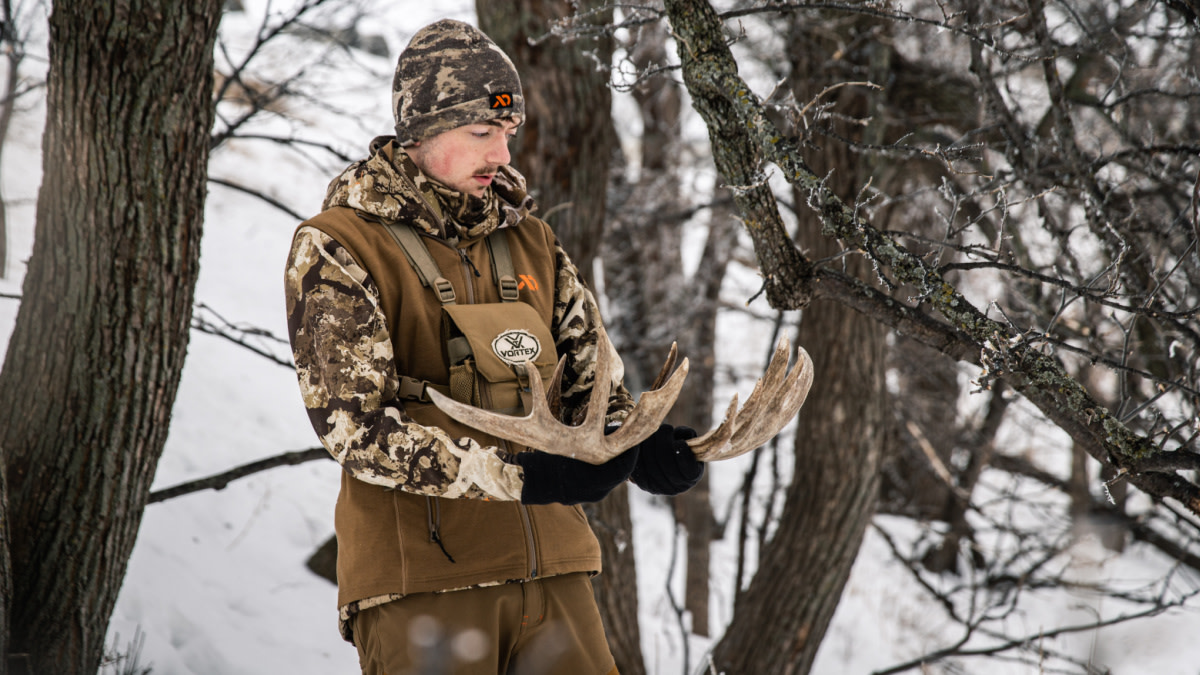
I spend as much time (if not more) in the woods during the spring as I do during hunting season. Spring scouting can help you gather valuable intel for the next hunting season. My spring scouting regimen includes looking for whitetail sheds to figure out what bucks made it through the previous hunting season and harsh winter.
Big woods areas are arguably the most challenging places to find sheds due to the miles of timber with not many areas that congregate deer, as you may find in agricultural areas. Even though I’ve been doing it since I was a kid, most of the time I feel like I’m looking for a needle in a haystack leaving me empty-handed at the end of a 10 to 12 mile day of burning boot leather.
With that being said, there’s no more satisfying a feeling than when you start finding sheds in remote areas. Some years, I find most of my sheds in one place after a rough winter that caused them to congregate. In other years with milder weather, they seem to be spread out further and more randomly.
Food Sources Food sources are the first place to scout when looking for whitetail sheds in the big woods. Unfortunately, food sources aren’t as easily identifiable in big-timbered areas that don’t have food plots or agriculture. This shifts your focus to natural food sources like newer logging cuts, mature oak ridges, and swampy grass bottoms. Within these areas, look for woody browse like beech twigs, eastern white pine seedlings, maple twigs, mountain laurel twigs, blackberry briars, tops of trees cut during logging, and oak twigs in concentrated areas.
Logging cuts usually have multiple different browse in one location. If you find an oak ridge with acorns left on the ground, you’ll find the deer. If there’s still snow on the ground, it’s pretty straightforward to find these feeding areas. Lastly, spring seeps coming out of the side of the hills and swampy bottoms will stay thawed longer than other areas making it easier for deer to dig for plants, grasses, and other browse even in the roughest of winters.
Bedding Areas Deer spend most of their day within their bedding areas, which means it can be a great place to look for shed antlers. I tend to hold off on looking into bedding areas until middle to late March after the snow has melted so that I don’t put any unnecessary pressure on them after a hard winter.
Winter bedding areas are usually close to food and have good thermal insulation from conifer trees. In hilly areas and mountain country, south-facing slopes get the most sunlight and attract deer bedding and feeding. In many regions, loggers will leave the big pine and hemlock trees on the interior of the logging cuts. If I see one from a distance, I’ll make sure that I look underneath it. Rarely I won’t find a deer bed underneath one of these conifer trees and sometimes a shed or two.
Trail Systems Focusing on critical areas where deer spend most of their time is how you will get the most out of your time. When shed hunting these areas, walk deer trails as they would, to get from point A to point B. Refrain from wandering because in the winter bucks seem to travel many of the same trails as other deer, as opposed to fall or summer when they tend to be lone rangers roaming far from the beaten path.
Strategy The key to finding sheds in the big woods is to focus your time on these high-priority areas and be thorough in your efforts. It’s easy to walk past sheds in the big woods unless you’re covering the focus areas in their entirety in a grid-type fashion. It’s better to cover a smaller area with a lot of sign by walking back and forth every 30 to 45 feet than it is to half-ass cover a large area. Repeat this grid search throughout the food sources and bedding areas that you’ve identified rather than aimlessly rambling through the woods.
If you’re new to the location and don’t have those areas identified prior, cover ground until you find these particular areas and then start grid searching. Don’t overthink it. Spend time in the best locations and cover them thoroughly. It can be frustrating at times but enjoy the process, learn from the sign you find, and it will just be a matter of time before you start finding shed antlers in big woods.
Feature image via Captured Creative.






